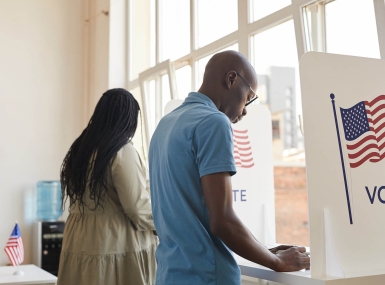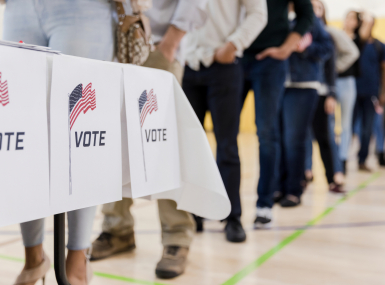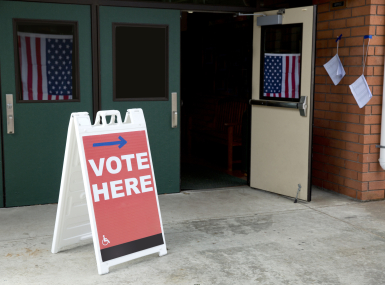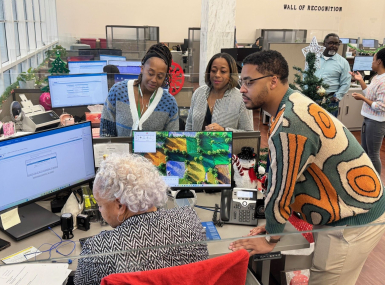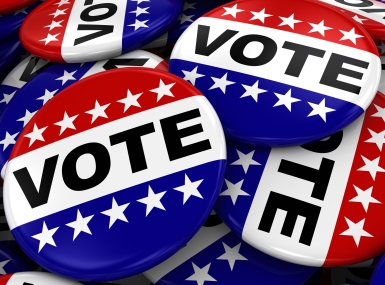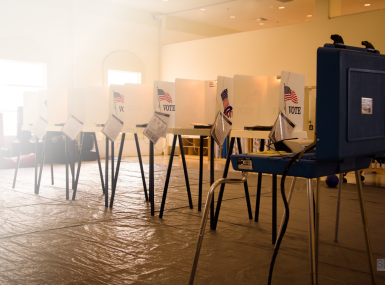The County Role in Elections: How Counties Administer Secure Elections

Author

Paige Mellerio
Upcoming Events
Related News
Elections in the United States are administered in a highly decentralized process through which each state shapes its own election laws. In turn, states shape the roles counties play in the months and weeks leading up to Election Day. The federal government also plays a role through the U.S. Election Assistance Commission (EAC), which serves as the federal clearinghouse for election related technical assistance and makes grants when funding is available to aid states and local governments. Still, the majority of election responsibilities are concentrated at the state and local level. Intergovernmental partnership is crucial to the integrity of elections, but it requires a delicate balance that recognizes the important role counties play in administering a secure and accurate election. The county role in election administration is vital to the democratic process and should be recognized as such.
The County Role in Elections
The nation’s 3,069 counties traditionally administer and fund elections at the local level, including overseeing polling places and coordinating poll workers for federal, state and local elections. County election officials strive to administer elections in a way that is accurate, safe, secure and accessible for all voters. Counties are responsible for funding and managing over 100,000 polling places staffed with over 630,000 poll workers each election cycle. More than 203 million people were registered and eligible to vote within jurisdictions where counties played a significant role in election administration in 2020.
Counties are responsible for funding and managing over 100,000 polling places staffed with over 630,000 poll workers each election cycle.
The 2020 election cycle was the most unprecedented in recent history in that the election was administered during a global pandemic, a period of civil unrest and amidst persistent misinformation and disinformation on social media about the administration of elections. Counties also had to adapt to the increase in voter turnout and the changing nature of voter participation. According to the U.S. Census Bureau, approximately 67 percent of voting age Americans reported voting in the 2020 general election – an increase of 5 percentage points above the turnout in the 2016 general election.1 Counties provided election-related services to more than 145 million people who voted in county-administered jurisdictions and whose votes were counted during the 2020 general elections, an increase of approximately 20 million more voters than the comparable level in the 2016 general elections.
Due to the COVID-19 pandemic, more people opted to vote-by-mail or vote during an early voting period prior to Election Day. According to the U.S. Election Assistance Commission (EAC), states reported more than double the number of mail-in ballots cast in the 2020 general election as compared to the 2016 general election.2 During the 2020 general election, more than 63.7 million people voted by mail and over 39.1 million voted in-person during an early voting period. This is compared to over 32 million by-mail voters and over 21.9 million early voters in the 2016 general election.
Despite these challenges, counties in partnership with our state and federal partners were able to administer an election called the “most secure in American history.”3
Counties & Election Security
Election security is paramount to the integrity of the democratic process and the general confidence that an election was administered without any interference and the results are accurate. To administer a safe and secure election, counties operate within the boundaries of state law and federal guidelines but are responsible for several aspects of election security before, during and after an election. These include:
- Testing voting machines
- Storing voting machines and other physical voting equipment in secure locations
- Ensuring ballot boxes are secure and not tampered with
- Training poll workers
- Voting system and ballot chain-of-custody procedures
- Physical voting location security
- Cybersecurity assurances
- Threat mitigation and contingency planning
County election officials work diligently to ensure the safety and security of the entirety of our voting systems from the machines used to cast ballots to election workers themselves.
Voting Machines
Voting machines are the voters’ primary focus on Election Day and counties are responsible for selecting and purchasing voting machines and equipment. Through the Help America Vote Act of 2002 (HAVA), Congress also sought to improve the election process by promoting the latest technology and moving away from traditional lever and punch-card machines. Today, approximately three out of every five counties use optical scan technology, which employs a scanner to read voter marked paper ballots and record the results. Two out of five counties use direct recording electronic (DRE) equipment that allows voters to make their selections via touch screen or other digital interface and records the results on memory devices. During early voting and on Election Day, county election officials back up these records frequently on several memory devices to ensure votes are counted accurately even in the case of an emergency that interferes with voting system, whether it be a cyber incident or natural disaster. Almost all DRE machines are also equipped with voter-verified paper audit trail (VVPAT) equipment that prints a permanent paper record that allows the voter to review a paper record of their votes before casting the ballot.
According the EAC, only 32 jurisdictions nationwide reported using DREs without VVPAT equipment by 2020.4
While voting machine types may vary by state or county, every state has specific policies governing voting machine certification and testing, setup, storing and security that counties must comply with.
Voting machine testing is often conducted by voting machine vendors but require state certification before counties can purchase the machine. For the testing and certification, some states adopt federal guidelines and standards and while others create their own. As required by HAVA, the EAC develops Voluntary Voting System Guidelines (VVSG) with input from the public and the EAC Standards Board and Board of Advisors. The VVSG sets specifications and requirements against which voting systems can be tested to determine if the systems meet standards related to basic functionality, accessibility and security. The VVSG is completely voluntary for states and is limited to EAC-certified voting systems. Only 11 states and the District of Columbia (D.C.) statutorily or regulatorily require full EAC-certification for voting equipment, although 38 states and D.C. use at least some aspect of these federal certification requirements in addition to state-specific requirements.5 Additionally, most vendors use labs that have been certified by the EAC with input from the National Institute of Standards and Technology (NIST).
EAC Standards Board
The EAC Standards Board is a 110-member board comprised of 55 state election officials and 55 local election officials, including several county election officials.
EAC Board of Advisors
The EAC Board of Advisors is a 35-member board comprised of representatives from several federal agencies, members of Congress, and organizations representing election officials or other election-related matters, including NACo.
Once counties acquire state certified voting equipment, county election officials conduct additional tests of the machine to ensure it can process ballots and accurately count votes. This testing is almost always open to the public so voters can cast their ballot with confidence that it being counted accurately.
The transport and storage of voting machines are directed by state and local security protocols. County election officials undertake rigorous, documented chain of custody procedures before, during and after an election when transporting and delivering voting machines to ensure accountability, transparency and security. Voting machines are also often equipped with tamper evident seals and are stored in secure, secondary locations that are in some cases monitored by video surveillance and/or physical security officers at all times.
Cybersecurity
As technology evolves, cybersecurity is becoming a larger consideration for county election officials to maintain the security of voting systems and public confidence in elections. Cybersecurity testing for voting machines is not explicitly required by HAVA, but many counties implement several cybersecurity measures to ensure the security of voting systems and to prevent bad actors from interfering in the elections process. For example, voting machines are never connected to the internet or to each other and only certain election officials with special credentials are able to access the physical location of the network and other critical election technologies.
In February 2021, the EAC issued the VVSG 2.0 guidelines which included cybersecurity standards for the first time. These include guidelines and standards related to software independence, multi-factor and authentication and data protection that are now required for EAC certification. VVSG 2.0 was the first major overhaul of the guidance since 2005. Additionally, the EAC works with the Cybersecurity & Infrastructure Security Agency (CISA) to provide guidance to state and local governments related to election infrastructure security.
Ballot Security
Counties work with our state and federal partners, ensure the privacy, security and validity of ballots before, during and after election day.
This includes mailing absentee ballots to voters, including to military and overseas voters as required by the Uniformed and Overseas Citizens Absentee Voting Act (UOCAVA). While some states have long allowed no excuse vote-by-mail and even primarily administer their elections exclusively by mail, several states eased their absentee ballot limitations to allow vote-by-mail to become more accessible during the COVID-19 pandemic. Even when ballots are cast using mail-in voting, counties and our intergovernmental partners take many steps to ensure ballot security and detect voter fraud.
Transporting Ballots
Ballots delivered by mail are processed by the U.S. Postal Service (USPS). When handling ballots, the USPS undergoes strict chain-of-custody procedures. In response to the high volume of mail-in ballots cast in the 2020 elections and during the COVID-19 pandemic, the USPS took special measures to ensure ballots were handled properly, delivered on time and accounted for. For example, the USPS conducted daily ballot sweeps in postal facilities and required facility supervisors to certify and document that all ballots processed in that facility had gone out for delivery. The USPS is a critical partner to counties in elections.
Some states also allow the use of ballot drop boxes or receptacles for ballot collection outside of a county elections office or polling place, although the scope of the use of ballot boxes varies from state to state. Like voting machines, county election officials monitor ballot drop boxes using 24-hour video surveillance and boxes are equipped with tamper evident seals. To collect ballots from a drop box, counties use a variety of security measures to prevent the tampering of ballots. This can include deploying specially trained teams to collect the ballots, often including representatives from both major political parties, who then deliver them to a secure location and follow strict chain of custody and documentation procedures.
Once mail-in ballots arrive at the county election office or secondary secure location for processing, the handling of ballots is limited to election officials with certain credentials to protect the privacy of voters and ensure the ballots are not tampered with. Some states allow mail-in ballots received prior to election day to be processed and tabulated upon arrival, while others require counties to wait until election day to process any ballots. Regardless of when the ballots can be processed, counties handle them with great care and ensure they are secure even after an election.
Despite the increasing popularity of early voting methods (i.e., mail ballots and in-person early voting), Election Day in-person voting is traditionally the most popular voting method for residents across the nation. Election day in-person voting accounted for more than half of participation from 2008-2018. Even when processing ballots cast in person, county election officials ensure that voting machines are secure and that voters have the right to privacy and to cast a ballot free from influence. County election officials and poll workers undergo extensive training to ensure ballots are handled securely and within the bounds of the law. Poll watchers from both major political parties, and in some cases nonpartisan poll workers, also monitor election administration at polling locations but are limited by state law in what they can do.
Voter Fraud Mitigation
Counties also ensure that fraud is not committed by voters. When individuals vote in person, voters are checked in by county election workers who verify the individual’s voter registration status and check their identification. While states are responsible for voter registration and maintaining poll books, counties comply with and uphold voter ID requirements that vary by state. Some states exclusively require photo ID and others some allow for other personal identifying documentation to cast a ballot. In-person voters whose identity or registration status cannot be immediately verified have the option to cast a provisional ballot that undergoes additional scrutiny. To count a provisional ballot, election officials can put the provisional ballot through verification processes or require voters to return to the election office within a certain timeframe to present their voter ID. County election officials typically keep provisional ballots separate from regular ballots and do not process them until the voters’ identity is verified and all regular ballots have been accounted for.
Even when voters use mail-in voting and are not under the direct supervision of election workers, county election workers verify the identity of the voter before the ballot can be counted. Although mail-in voter identification methods vary based on state law, more than half of states and territories require counties to put these ballots through signature verification using a variety of methods.6 These methods include advanced technologies as well as the use of specially trained analysts and representatives from both major political parties to compare the signature on the ballot envelope against signatures on file or on publicly available documents. If the signature on the ballot is un-verifiable, county election officials are required to notify the voter and allow them to “cure” or fix their ballot within certain timeframes dictated by state law.
Counting Ballots & Certifying Results
Counties comply with state laws dictating when mail-in ballots must be physically received to be counted. Some states allow mail-in ballots postmarked by the USPS by Election Day to be accepted while others require mail-in ballot to be delivered by election day to be counted.
As outlined previously in this report, many voting machines used by counties can record results as ballots are cast or processed, and these machines undergo rigorous testing and certification to ensure they can accurately tabulate and record votes. In elections, voter-marked paper ballots and VVPATs are used as the vote of record for audits, recounts and general election counts.
Final ballot counts are typically only managed by a limited number of specially trained county election workers and are backed up on several redundant memory devices as a security measure. The results reported on election night are unofficial and counties only report official results, or the “canvass,” to the state after all votes, including provisional ballots, are verified and counted. County election officials comply with state canvass deadlines and take great care to ensure the delivery of results to state election officials is conducted securely and without interference. This includes following strict chain of custody procedures.
In cases of automatic recounts and contested elections in which a recount is ordered by the court, counties follow strict procedures to ensure ballots are properly and accurately counted. Depending on the state and/or the specific rules of a recount and the voting machines used, counties either re-process voter-marked paper ballots, VVPATs or hand count the ballots. Counties and states are responsible for the costs associated with conducting an automatic recount.
Post-election Audits
Elections do not end for county election officials when polls close and ballots are counted. Following an election, county election officials conduct post-election audits to account for compliance and accuracy even when races are not close or contested. Post-election audits are often conducted within short time frames and some states require the completion of audits before certifying official results.
Following an election, county election officials conduct post-election audits to account for compliance and accuracy even when races are not close or contested
Counties also conduct post-election audits even when not required to by state law to ensure there was no error in voting procedure and tabulation as well as to assure voters that election results are accurate. These audits usually involve a review of chain of custody procedures and the recount of certain batches of voter-marked paper ballots or VVPAT records to compare against previous vote counts. The implementation of risk-limiting audits, a kind of post-election audit based on the margin of votes between candidates in a certain race, has in recent years become more popular amongst election officials.
Costs associated with conducting post-election audits are borne by the county with some support from the state. While NACo believes that post-election audits are an integral part of securing our elections and supports efforts to develop and assist counties in implementing best practices, NACo opposes any federal legislation that requires any specific methodologies.
Election Worker Safety
The widespread circulation of misinformation and disinformation surrounding the administration of elections has led to a series of new challenges election officials must address, including the increase of targeted threats and harassment towards election officials. Amidst these new challenges, counties now must also consider safety and security measures for themselves and the election workers they employ.
According to a March 2022 survey of approximately 600 local election officials and workers, 77 percent feel as if threats and harassment towards election officials has increased in recent years. Of surveyed election officials, 17 percent reported experiencing threats and harassment themselves, but more than half are concerned about the safety of their colleagues in future elections.7
According to a March 2022 survey of approximately 600 local election officials and workers, 77 percent feel as if threats and harassment towards election officials has increased in recent years.
To address these concerns, county election officials have deployed several mitigation strategies to ensure the safety of themselves and others. These measures are dependent on the frequency and severity of targeted threats and harassment in a county, and physical safety is an increasing concern for election officials as mis- and disinformation becomes more widespread. Mitigation strategies include, but are not limited to, equipping election offices with limited key card access, silent alarms, bulletproof windows and doors, video surveillance, and more. In the most extreme cases, high-level election officials who have received high volumes of targeted threats will be accompanied by security guards or receive protections from local law enforcement.
The same survey of local election officials, however, found that of the 17 percent of local election officials that reported receiving targeted threats and harassment, only 46 percent reported these threats to law enforcement. Of the election officials that reported threats, 89 percent reported these threats to local law enforcement and 22 percent reported to the Federal Bureau of Investigations (FBI). This means that a large majority of threats against local election officials and workers are not directly reported to the appropriate federal authorities.
In July 2021, U.S. Department of Justice (DOJ) launched the Elections Threats Task Force to address the rise in threats against elections workers and includes representatives from the Criminal, Civil Rights, and National Security Divisions of the DOJ, the Federal Bureau of Investigations (FBI) and U.S. Department of Homeland Security (DHS). As of August 1, 2022, the Task Force has reviewed over 1,000 cases of threats against the election community, however only 11 percent of these cases have met the threshold for a federal criminal investigation as they have included threats of unlawful violence and are therefore not protected by the free speech clause of the First Amendment.8
Counties encourage the DOJ to continue reviewing cases that are reported and working with local law enforcement to ensure that cases of threats towards election officials and workers are reported so they can be reviewed, investigated and in those cases that result in criminal indictment, appropriate penalties can be imposed.
The Cost of Running a Secure & Accurate Election
The cost of running elections is difficult to calculate and varies by county. The California Institute of Technology/Massachusetts Institute of Technology Voting Technology Project estimated county election expenditures were an estimated $1 billion in 2000. Costs associated with running elections have risen over time and following the passage of HAVA that implemented substantial election that included upgrading voting systems to ensure that voters could verify their selections before their ballot was cast.
The impact on counties of complying with federal and state election laws varies. The need to continually upgrade voting machines has increased the cost to administer elections. In addition to the cost of the actual equipment, there are costs associated with transporting units to and from polling locations, the printing of paper ballots (when applicable) and the annual maintenance of the machines. The impact on counties, however, depends on factors such as how many machines are used in the county, which vendor is selected for the machines and whether the vendor provides maintenance for the machines.
There are also costs associated with the recruitment, training and retention of high-quality election workers. Ensuring that individuals who volunteer their time to assist with the administration of elections are knowledgeable of and adhere to the laws, guidelines and safeguards surrounding elections is crucial to election security.
Beyond costs associated with election security, there are several other significant costs to counties associated with election administration. This includes expenses related to voter information pamphlets, language accessibility materials, Americans with Disabilities Act (ADA) accommodations and the signage/materials for polling locations.
Who Funds Elections?
While the majority of election-related costs are borne by counties, states support some facets of elections, such as maintaining statewide voter registration databases, contributing funding for voting equipment and supplies and disseminating information to voters.
In 2002, HAVA authorized the EAC to make grants for election security and general costs associated with the county role in elections. HAVA grants rely on annual discretionary appropriations enacted by Congress and are not consistently funded. HAVA grants were funded in 2018 for the first time since Fiscal Year (FY) 2010 in response to foreign threats to interfere in the elections. Re-introduced as “election security grants,” these grants were funded in FYs 2020 and 2022 to help states and local governments prepare for federal elections. These grants are allocated to the state using a formula based on the voting age population in the state although each state is guaranteed a minimum amount. States then have the discretion to either subgrant or provide advances to counties for certain election administration activities.
Counties support a consistent, predictable and dedicated federal funding stream to assist counties with meeting the significant federal requirements already imposed on local governments administering elections. Federal funding dedicated to election administration should be administered in coordination and in consultation with local governments, including an assurance that a portion of the funding be made available to the discretion of local governments. A consistent federal funding stream would allow counties to prepare for future technology and security updates, recruit, train and retain high-quality individuals that administer elections, as well as to provide continued access to voters.
Counties support a consistent, predictable and dedicated federal funding stream to assist counties with meeting the significant federal requirements already imposed on local governments administering elections
Administering a safe and secure election costs counties a significant amount of funding. As mis- and disinformation regarding the administration of elections and the resulting increase in threats and harassment towards election workers continue, the cost of elections continues to rise as counties must implement further security measures. A direct stream of federal funding would allow counties to implement the security measures necessary to continue to administer secure and accurate elections free of influence.
Until then, counties will continue to work with states to implement and fund necessary election security initiatives and advocate for direct funding.

